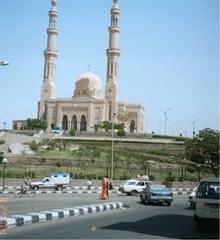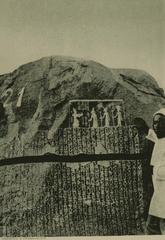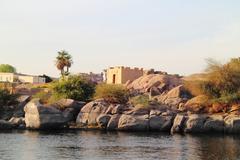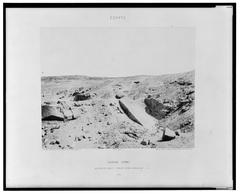Pyramid of Elephantine: Visiting Hours, Tickets, and Guide to Aswan Historical Sites
Date: 04/07/2025
Introduction
Nestled on Elephantine Island near Aswan, Egypt, the Pyramid of Elephantine stands as a remarkable testament to ancient Egyptian ingenuity and the strategic importance of Egypt’s southern frontier. Built during the Third Dynasty, around 2600 BCE, this modest step pyramid, although smaller than the famous pyramids of Giza, played a significant symbolic role. It underscored pharaonic authority over crucial trade routes and military borders adjoining Nubia, while also reflecting the island’s prominence as a religious and trading hub—especially in its association with Khnum, the ram-headed god of the Nile’s inundation.
Elephantine Island itself is a vibrant tapestry of archaeological wonders, including temples, the Nilometer, and thriving Nubian villages. Its proximity to Aswan and compact size make it easily accessible for day trips, offering visitors a rich blend of history, culture, and natural beauty. This comprehensive guide explores the history, architecture, cultural significance, and practical visitor information for the Pyramid of Elephantine and the island’s other highlights.
For more on Elephantine Island’s cultural and archaeological context, see egypttoursgate.com, Journey to Egypt, and Quit and Go Travel.
Historical Context of the Pyramid of Elephantine
Early Old Kingdom Origins
The Pyramid of Elephantine is one of a handful of “provincial pyramids” from the Third Dynasty, most likely commissioned by Pharaoh Huni. These small, step pyramids were strategically placed at Egypt’s borders, including Elephantine Island—then called ꜣbw (Abu or Yebu)—to reinforce royal presence and unity across distant regions. Elephantine’s position at the First Cataract of the Nile made it an essential trade and military hub, controlling routes to Nubia and the ivory trade.
Discovery and Archaeological Research
Discovered in 1907, the true significance of the pyramid was not understood until excavations by Günter Dreyer and the German Archaeological Institute in 1978–79. Unlike royal tombs, the Pyramid of Elephantine lacks burial chambers and funerary goods, suggesting a symbolic or cultic function rather than a funerary one (egypttoursgate.com).
Architectural Features
Location and Setting
The pyramid is located on the island’s southern tip, within Elephantine’s ancient city. The island itself is about 1,600 meters long and 450 meters wide, characterized by granite outcrops and dramatic views of the Nile’s cataracts.
Dimensions and Construction
Today, the pyramid stands approximately 5.5 meters (18 feet) high with a square base of about 18.6 meters (61 feet) per side. Built from local sandstone blocks and a rubble core, the simple step design bridges the gap between earlier mastabas and the later smooth-sided pyramids.
Unique Features
Unlike the large pyramids at Giza, the Elephantine pyramid contains no internal chambers or corridors. Its utilitarian construction suggests it was built quickly with available local materials.
Connection to Other Provincial Pyramids
The Elephantine pyramid is one of seven similar structures erected during the Third Dynasty. These pyramids, scattered along Egypt’s frontiers, reinforced the pharaoh’s authority and the unity of the state (wikipedia).
Cultural and Historical Significance
Symbol of Royal Power
Strategically placed at Egypt’s southern border, the pyramid served as a visible sign of pharaonic control over both trade and religious life in the region.
Religious Importance
The pyramid’s proximity to temples dedicated to Khnum and other local gods ties it to regional religious practices. Rituals conducted here reinforced the divine legitimacy of the pharaoh’s rule.
Archaeological Legacy
The pyramid, alongside other Elephantine treasures, contributes to the island’s UNESCO World Heritage status. Excavations have revealed artifacts from prehistoric times through the Greco-Roman period, including the famous Elephantine Calendar and mummified rams of Khnum (egypttoursgate.com).
Cultural Significance and Strategic Importance
Religious and Mythological Importance
Elephantine Island was revered as the home of Khnum, controller of the Nile’s inundation and creator of life. The pyramid likely formed part of a greater religious complex, playing a symbolic role in rituals connected to the annual flood (egypttoursgate.com).
Cultural Exchange
Artifacts and inscriptions show that Elephantine was a crossroads of Egyptian, Nubian, and Aramaic-speaking Jewish cultures, reflecting centuries of interaction and multicultural heritage (egypttoursgate.com).
Military and Economic Significance
As a fortified outpost, Elephantine controlled access to Nubia and the valuable ivory, gold, and exotic trade routes. The pyramid’s placement near the harbor may have welcomed traders and dignitaries (egyptatours.com).
Mysteries and Unanswered Questions
The function of the Elephantine pyramid remains debated. Its small size, absence of burial chambers, and lack of inscriptions suggest it was more likely a symbolic monument or regional cult center than a tomb. The pyramid’s alignment with cardinal points demonstrates the ancient Egyptians’ advanced astronomical knowledge. Its construction from local granite and mudbrick reflects the resources and constraints of provincial sites (egypttoursgate.com).
Visitor Information
Visiting Hours
- Archaeological zone (including the pyramid, Temple of Khnum, and Nilometer): Daily, 9:00 am – 5:00 pm
- Aswan Museum: Daily, 9:00 am – 4:00 pm
Check locally for variations during holidays or special events.
Tickets and Admission
- Archaeological zone: About 80 EGP for adults; discounts available for students and children. Covers most sites on the island.
- Aswan Museum: About 40 EGP; ticket purchased separately at the museum entrance.
Tickets are available at entrance booths; online booking is not currently offered.
Getting There
Elephantine Island is accessible by frequent public ferries from Aswan’s Corniche waterfront (EGP 5 per person per ride), or by hiring private motorboats or feluccas for a scenic experience (Quit and Go Travel).
Accessibility
The island’s archaeological sites feature uneven and sandy terrain, so visitors with mobility issues may require assistance. Most of the island is pedestrian-only.
Guided Tours
Local guides are available for hire at both Aswan and on Elephantine Island. Guided tours offer deeper historical and cultural context, enhancing your visit.
Nearby Attractions
- Temple of Khnum: Ancient temple honoring the creator god of the Nile’s source.
- Nilometer: One of Egypt’s best-preserved water level measuring devices.
- Aswan Museum: Artifacts from Elephantine and Nubian culture.
- Nubian Villages (Siou and Koti): Explore vibrant local culture and crafts.
Photographic Opportunities
Capture the pyramid against the Nile and desert backdrops, especially in early morning or late afternoon light.
Additional Experiences
- Felucca rides: Enjoy a traditional sail around the island (Third Eye Traveller).
- Cultural encounters: Visit Nubian homes for tea, crafts, and stories (Earth Trekkers).
- Nature walks: Experience lush gardens and excellent birdwatching spots.
Practical Visitor Tips
- Dress modestly and comfortably; bring sun protection, water, and sturdy shoes.
- Be respectful when photographing people or religious spaces.
- Best time to visit is October–April for mild weather.
- Stay in Aswan for easy boat access to the island.
- Participate in local tours and cultural workshops for deeper engagement.
Preservation and Conservation
The Pyramid of Elephantine faces threats from erosion, rising water levels, and climate change. Egyptian authorities, with international partners, work to conserve the structure and promote sustainable tourism. Community engagement programs help preserve the island’s heritage (egyptatours.com).
Frequently Asked Questions (FAQ)
Q: What are the Pyramid of Elephantine and Elephantine Island visiting hours?
A: Archaeological sites are open daily from 9:00 am to 5:00 pm; the museum from 9:00 am to 4:00 pm.
Q: How do I reach Elephantine Island?
A: Take a public ferry or hire a felucca/motorboat from Aswan Corniche.
Q: Where can I buy tickets?
A: At entrance booths on the island; no online booking.
Q: Are guided tours available?
A: Yes, local guides offer tours in several languages.
Q: Is the pyramid accessible for visitors with mobility issues?
A: Terrain can be uneven; assistance is recommended.
Summary
The Pyramid of Elephantine provides a unique window into the early Old Kingdom and Egypt’s efforts to project power and religious influence along its southern border. Surrounded by rich archaeological sites and vibrant Nubian culture, Elephantine Island is an essential destination for those exploring Aswan and Egypt’s ancient heritage. With accessible transport, affordable tickets, and a variety of attractions, a visit promises history, culture, and natural beauty in equal measure.
For further details and the latest updates, consult egyptatours.com, egypttoursgate.com, and Hurghada Lovers.
Alt text: Pyramid of Elephantine showing its stepped design against the Nile backdrop in Aswan.
Additional Resources
- Egypt Tours Gate: Elephantine Island
- Egypt a Tours: Elephantine Island
- Quit and Go Travel: Aswan Guide
- Hurghada Lovers: Elephantine Island
- Journey to Egypt: Elephantine Island
For travel tips, ticket bookings, and exclusive content, download the Audiala app and follow us on social media.




